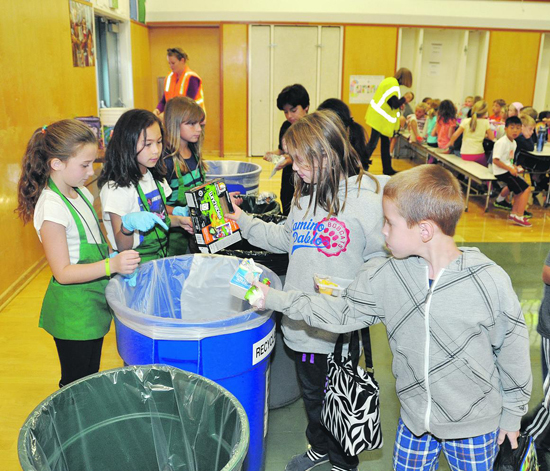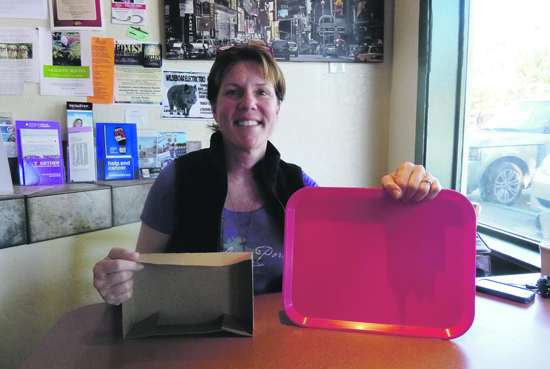| | Published November 6th, 2013
| On The Way To 75 Percent Diversion Rate, Schools Do Their Part
| | By Sophie Braccini |  | | From left: Green Team members Jessica Finnerty, Amy Blei, and Anna Rossi supervise trash disposal as students Charlie Lopez, Elsie Bulling, and Colin Baker choose the right bin. Photo Andy Scheck
|
Central Contra Costa Solid Waste Authority recently released its diversion rates for 2012, with Lamorinda hitting the 66 percent mark, a good start toward the 2020 objective of 75 percent. Because collection services are available to individual homes, they are the most efficient at diverting, so the target for improvement is with businesses, multi-family dwellings and schools. In Lamorinda, schools have made great strides toward the goal and are tackling the last pockets of trash going to the landfill.
 "Camino Pablo Elementary in Moraga has been leading for some years, they are showing us the way of the future," says Ruth Abe, a HDR Engineering technical consultant to schools, hired by CCCSWA. "They should be the first to reach the 75 percent diversion rate."
"Camino Pablo Elementary in Moraga has been leading for some years, they are showing us the way of the future," says Ruth Abe, a HDR Engineering technical consultant to schools, hired by CCCSWA. "They should be the first to reach the 75 percent diversion rate."
 On site, science coordinator Bonnie Hazarabedian is in charge of the recycling effort. "We started 10 years ago," she says, "and we'll soon be at a point where it will be very hard to find additional things to remove from the landfill bin."
On site, science coordinator Bonnie Hazarabedian is in charge of the recycling effort. "We started 10 years ago," she says, "and we'll soon be at a point where it will be very hard to find additional things to remove from the landfill bin."
 The first big step was perfecting the lunch time food recycling program. "We have a green leadership team made of fourth- and fifth-graders who supervise the food scrap sorting at lunch time ," she explains. This year the schools can incorporate soiled napkins and papers into their compostable food scraps, including the paper towels from washrooms and classrooms. "And what has helped, too, are the families' practice of giving their kids less and less disposable lunch bags, and more reusable lunch pails with reusable containers and utensils," adds Hazarabedian.
The first big step was perfecting the lunch time food recycling program. "We have a green leadership team made of fourth- and fifth-graders who supervise the food scrap sorting at lunch time ," she explains. This year the schools can incorporate soiled napkins and papers into their compostable food scraps, including the paper towels from washrooms and classrooms. "And what has helped, too, are the families' practice of giving their kids less and less disposable lunch bags, and more reusable lunch pails with reusable containers and utensils," adds Hazarabedian.
 Unlike with home recycling, where food scraps mix in the green waste, the schools have the same food scrap service as restaurants. Since the hauler gets revenue from the back end of this service, food scrap recycling is free to users.
Unlike with home recycling, where food scraps mix in the green waste, the schools have the same food scrap service as restaurants. Since the hauler gets revenue from the back end of this service, food scrap recycling is free to users.
 "This November we will introduce new small food waste containers for the classrooms where kids will be able to recycle their snack food waste and napkins," says Hazarabedian. "The teachers will bring those to a centralized location at the end of the day so as not to add to the custodian's work load." Hazarabedian explains that buy-in from all staff is crucial. "We are lucky to have Alberto Hernandez-Cortez as our custodian here," she says. "He got the custodial award a couple of years ago. He is so proactive and will tell me when we need a smaller landfill waste container or additional recycling ones."
"This November we will introduce new small food waste containers for the classrooms where kids will be able to recycle their snack food waste and napkins," says Hazarabedian. "The teachers will bring those to a centralized location at the end of the day so as not to add to the custodian's work load." Hazarabedian explains that buy-in from all staff is crucial. "We are lucky to have Alberto Hernandez-Cortez as our custodian here," she says. "He got the custodial award a couple of years ago. He is so proactive and will tell me when we need a smaller landfill waste container or additional recycling ones."
 Hazarabedian is also working on recycling the bathroom towels and got a new container for the Bobcat Club, the after-school program. "All we have left in the trash now are non-recyclable plastics and utensils," she says.
Hazarabedian is also working on recycling the bathroom towels and got a new container for the Bobcat Club, the after-school program. "All we have left in the trash now are non-recyclable plastics and utensils," she says.
 Abe says that she is supporting other Lamorinda schools with similar programs: Del Rey and Glorietta elementary schools in Orinda, and Orinda Intermediate School where teachers Kristen Nielson and Suzy Kisch have taken a lead on a very extensive program that includes onsite composting and gardening. The other two elementary schools in Moraga, Los Perales and Rheem, and Joaquin Moraga Intermediate School are all going in the same direction, composting on site and involving students.
Abe says that she is supporting other Lamorinda schools with similar programs: Del Rey and Glorietta elementary schools in Orinda, and Orinda Intermediate School where teachers Kristen Nielson and Suzy Kisch have taken a lead on a very extensive program that includes onsite composting and gardening. The other two elementary schools in Moraga, Los Perales and Rheem, and Joaquin Moraga Intermediate School are all going in the same direction, composting on site and involving students.
 In Lafayette, the effort is also supported by Sustainable Lafayette and Nanette Heffernan, who leads the Lafayette Green School initiative. In most Lafayette elementary schools, lunches were served by Choice Lunch to the children on cardboard trays that were tossed. Heffernan's idea was to have children use reusable trays that would not have to be trashed - a savings in terms of volume and cost of recyclables.
In Lafayette, the effort is also supported by Sustainable Lafayette and Nanette Heffernan, who leads the Lafayette Green School initiative. In most Lafayette elementary schools, lunches were served by Choice Lunch to the children on cardboard trays that were tossed. Heffernan's idea was to have children use reusable trays that would not have to be trashed - a savings in terms of volume and cost of recyclables.
 "It took two years to implement the pilot program at Springhill," explains Heffernan, "there were some legal complications and Sustainable Lafayette ended up buying the trays and creating the system to haul them back and forth to be cleaned (the schools don't have kitchens)." She says the system has been going on without a hitch. "Because we now reduced our recycling by 75 percent, Springhill will be able to go from two pick-ups a week to one pick-up a week, saving the district $2,000 a year," she commented. "We're hoping we can get the district to finance trays for the other schools."
"It took two years to implement the pilot program at Springhill," explains Heffernan, "there were some legal complications and Sustainable Lafayette ended up buying the trays and creating the system to haul them back and forth to be cleaned (the schools don't have kitchens)." She says the system has been going on without a hitch. "Because we now reduced our recycling by 75 percent, Springhill will be able to go from two pick-ups a week to one pick-up a week, saving the district $2,000 a year," she commented. "We're hoping we can get the district to finance trays for the other schools."
 Heffernan adds that there are more opportunities for schools. She is excited that paper towels and soiled paper containers can be added to the free food scrap recycling program. "That's huge," she says. "All we need is to get the district behind us and retrain staff. The district savings could reach $40,000 a year (according to CCCSWA) for a behavior change that is minuscule. Everybody wins."
Heffernan adds that there are more opportunities for schools. She is excited that paper towels and soiled paper containers can be added to the free food scrap recycling program. "That's huge," she says. "All we need is to get the district behind us and retrain staff. The district savings could reach $40,000 a year (according to CCCSWA) for a behavior change that is minuscule. Everybody wins."
 She believes that it will take two years to get Lafayette where it could be and to reap all the financial benefits from diverting. Her next step will be to reach out to all the private schools.
She believes that it will take two years to get Lafayette where it could be and to reap all the financial benefits from diverting. Her next step will be to reach out to all the private schools.


|
 | | Nanette Hefferman holding the old and new tray Photo Sophie Braccini
| | | | | | | | | | | | | |
| | | print story
Before you print this article, please remember that it will remain in our archive for you to visit anytime.
download pdf
(use the pdf document for best printing results!) | | | Comments | | |
| | | | | | | | | | | | | | | | |



